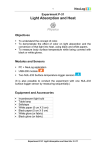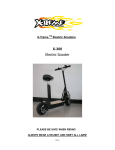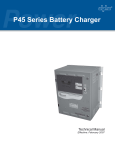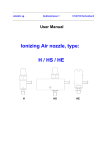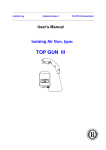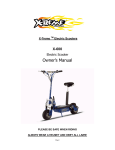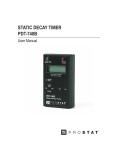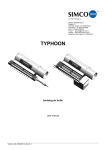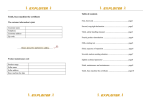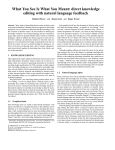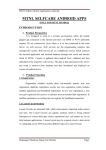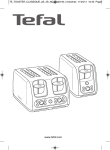Download ELECTROSTSTIC FIELDMETER
Transcript
431 ELECTROSTSTIC FIELDMETER OPERATION MANUAL Thank you for purchasing our electrostatic field meter. Please carefully read this manual before operating the system. Store this manual in a safe, easily accessible place for future reference. Note: * Please accord to the “note” for preventing the meter from damage. * Please not hit the sensor part. * Please not wet the meter and not use the meter with wet hands. * Please use the original parts when replacing the fittings. * Please turn off the power supply when finishing using and take out the battery when not using in a period of time. 1.Summary This electrostatic field meter is a special meter for testing the static and can test the ion balance. It can test quickly and effectively the static with untouched sensor, such as plastic, chemical fiber, pelage and the static of the body and so on. Page1 2.Product Instruction and Parts Product instruction 2 The meter cannot run when the voltage is lower. And in the testing process, the meter sounds firstly and turns off automatically. At the moment, it must replace a new battery. 3 Replace a new battery: move the lid and take out the valid battery. And then replace a new battery (refer to the picture). 1 2 3 4 ELE CTR OST ATI CF IEL DME TER POWE R 1、LCD 6、calibrating hole 2、POWER key 7、grounding jack to the meter 3、ZERO key 8、notch of testing ion balance 4、STATIC/IB key 9、ion balance testing plate 5、HOLD/MAX key 10、grounding line Page2 Note: * Please turn off the power supply when not using. * Do not replace the new battery in the testing process for protecting the meter from being damage. Page15 6 Press “HOLD/MAX” key into hold process or max process Display on the LCD when it is necessary to keep the testing value or maximal value. 7 Press “POWER” key to turn off the meter when finishing the test. 9 Note: * The measure precise is correlative with the measure distance between the sensor induces and the back testing 4 0-220V 0-1.5kV 1.0-22.0kV 0-220V 0-1.5kV 1.0-22.0kV MAX HOLD IB A.ON 5 7 kV board. So the ion balance testing board must be inserted 10 to the setting position. 6 11 * Do not touch the ion balance testing board when testing or else the voltage in the front testing board will be 8 EL 12 eliminated. 5. Replace the battery 1 means the voltage is full, enough, means the voltage is means the voltage is not enough, 1、negative measurement 7、continuous work 2、coordinate 8、LCD lighting 3、positive measurement 9、measuring range 4、MAX 10、testing data 5、HOLD 11、unit 6、ion balance testing 12、battery range means the voltage is near to end. Page14 Page3 2.3 Parts The meter includes following parts as the table. Please check all the parts are well and if the parts are damaged, please contact with the agents or our company. NO. Parts Quantity 1 Electrostatic field meter 1 2 Testing plate of the ion balance 1 3 Grounding line 1 4 9VDC battery 1 5 Operation Manual 1 6 Maintaining card 1 1 Insert the ion balance testing plate to the notch (refer to the 3.Specifications picture) and it must insert to the end. 2 Press “POWER” key to select the working mode and press Power supply: 9VDC Display: “STATIC/IB” key into the ion balance testing process after the LCD Static testing range : low 0~±1.50KV high 1~±22.0KV (Auto –switch between low and high) ion balance testing range: 0~±220V measure distance(static): 25mm(±0.5mm) Page4 static testing state. 3 connect the front testing plate to the “ground of the meter” and zero if the displaying value is not zero (refer to the 4.2). 4 connect the “ground of the meter” to the grounding of the Static Eliminator device. Page13 Testing precise: ±10% some distance to test the ion balance. Waiting current: <3uA When it is necessary to keep the testing value or maximal Working current: <15mA value. Surroundings: 0℃~50℃, humidity<80% Surface: ESD safe 5 the Static Eliminator device such as ionic air blower and keep 6 Press “power” key to turn off the meter when finishing the test. Note: the measure precise is correlative with the measure Size: 125mm×70mm×25mm Weight: 200g(including battery and testing plate of the ion balance) distance (25mm). When the “+” is more clearer and the measure distance is more nearer 25mm. 4.6 Ion Balance Testing Instructions 4. Operation Instruction Pressing “power” key to select the working mode and there are four modes to select. Refer to the following table. the front testing plate Mode1 Mode2 Mode3 the back testing plate EL E CT RO ST AT POWE R IC ME TE R the notch insert the ion balance testing plate to the notch Page12 Page5 Mode4 Mode1 Mode 2 Mode 3 Mode 4 “power” the tested object 25mm Pressing 1s-2.5s 2.5s-3.5s 3.5s-4.5s 4.5s-5s "+" graphemic time LCD Sound display “1” di display display “2”and “3”and “EL” “A.ON” di di-di-di “4”、 “EL”and ELE CTR O STA TIC POWE R FIE L DME T ER “A.ON” grounding di-di-di Continuous work and not Turn off the power turn off the power supply supply after working Mode display automatically (A.ON). five minutes. 1 Press “power” key to select the working mode and then go into the static testing process. 2 Ground the meter. state LCD LCD with LCD LCD with without lighting without lighting lighting (EL) lighting (EL) 3 Avoid objects with electricity and then zero if the display is not zero value (refer to the 4.2). 4 The front part of the meter is parallel to the tested object about 25mm and the displaying value on the LCD is the static value 2 Manual turns off the meter: press the “power” key when working “OFF”. Page6 until displaying carried by the tested object. The measure distance is about 25mm when seeing a clear red “+”on the tested object. 5 Press “HOLD/MAX” key into hold process or max process Page11 MAX: keep the current maximal value until testing more bigger value. In max process, lock the functions of “STATIC / 4.2 Zero IB” and “ZERO” until exiting the MAX process. Note: ENTER: press “HOLD/MAX” key until display “MAX” 1) Ground of the meter: default 0 of the meter to max process. EXIT: *The grounding line is “Ground of the meter” when insert it press “HOLD/MAX” key to exit the max process (without display “MAX”). into the grounding hole of the meter. *The surface is ESD and it is “Ground of the meter”. 2) Conductor: the resistance of the meter is high and the body, water, wet some things, earth and some wall are conductors. 4.5 Static Testing Instructions 3) Grounding: ground to the earth. Grounding of the meter: connect the “Ground of the meter” with the grounded things. The grounded thing is connecting to the earth. For example: some wall and bricks, some chairs and F TIC TA OS CT R ELE front part of the meter R POWE the sensor induces "十"graphemic body wearing antistatic footwear and so on. 1 The meter must be zeroed before testing the static and the ion balance. 2 The zeroed methods of the static testing: * Grounding first and then press “ZERO” key about two seconds and test the grounding things to zero. After un-pressing the key, the meter sounds and displays 0 if Page10 Page7 R ETE DM IEL power supply. zeroing successfully. * Grounding first and then press “ZERO” key about two seconds and avoid objects with electricity to zero. After un-pressing the key, the meter sounds and displays 0 if 2 press “STATIC/IB” key to the ion balance testing (display “IB”). 3 press “STATIC/IB” key again to return to the static testing. zeroing successfully. * Connect the conductor to the “Ground of the meter” first Press “STATIC/IB” key Static testing Ion balance testing and then press “ZERO” key about two seconds and test the conductor to zero. After un-pressing the key, the meter sounds and displays 0 if zeroing successfully. For example: one hand handholds the meter and put the other hand as conductor in front of the meter to zero. 3 The zeroed method of the ion balance testing: Insert the ion balance testing plate firstly and then connect the 4 press “STATIC/IB” key again to the ion balance testing. 4.4 HOLD/MAX HOLD: keep the current testing value for recording it. And lock the functions of “STATIC /IB” and “ZERO” until exiting the HOLD process. ENTER: press “HOLD/MAX” key (less than 1.5s) to hold “front testing plate” to the “Ground of the meter”. Press (display “HOLD” EXIT: press “HOLD/MAX” key to exit the hold process (without display “HOLD”). 4.3 switch between the static testing and the ion balance testing 1 the meter runs into the static testing after switching on the Page8 after un-press the key). “ZERO” key about two seconds to zero. After un-pressing the key, the meter sounds and displays 0 if zeroing successfully. process Page9









